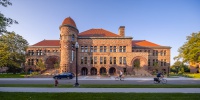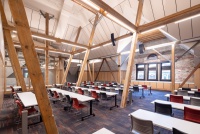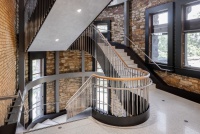Project Overview:
Pillsbury Hall, the second oldest building on the University of Minnesota’s campus, has been thoughtfully transformed through an award-winning rehabilitation focused on historic preservation engineering and adaptive reuse. For over a century, this iconic stone structure served the sciences. BKBM’s structural engineering expertise enabled the conversion of over 60,000 square feet of outdated science labs into vibrant, modern spaces—now home to the English Department, Creative Writing Program, and Liberal Arts Engagement Hub.
Historic Preservation Engineering Challenges & Solutions:
- Basement Excavation & Foundation Upgrades:
Pillsbury Hall originally sat on a defunct crawlspace. BKBM engineered the careful excavation of a new full-height basement, adding 2,500 square feet of mechanical utility space and connecting the building to the University’s pedestrian tunnel system. Extensive underpinning and micropiles ensured safe excavation and preserved the building’s stability throughout construction. - Structural Renewal:
The first-floor structure above the new basement was upgraded—replacing wood joists and cast-iron columns with steel framing and composite deck, while retaining the historic structural grid. This approach honored the past while delivering new strength and flexibility. - Adaptive Reuse & Seamless Access:
At grade, BKBM facilitated the transformation of second-level arched window openings into accessible ground-level entrances. This creative adaptive reuse preserved the historic masonry façade and greatly improved building access. - Tower Transformation:
Pillsbury Hall’s iconic stone tower was opened to the attic via a new sculptural stair, uniting all building levels and showcasing original heavy-timber framing. Steel tube reinforcement inside the masonry enabled this grand redesign while honoring historic integrity. - Preservation Meets Modernization:
Through every phase, BKBM’s structural solutions balanced heritage with modern needs—revealing original rusticated stonework, reinforcing aged materials, and preparing Pillsbury Hall to serve generations of students to come.
Years-in-the-Making, Designed for Generations:
BKBM joined the Pillsbury Hall project team in 2015 for predesign and assessment, guiding budget and design. Construction commenced in 2020 and was completed by August 2021, in time for the building to welcome a new era of students and academic communities.
Results:
The Pillsbury Hall rehabilitation project stands as a model for historic preservation engineering and adaptive reuse in Minneapolis. Award-winning design and engineering deliver a revitalized, accessible, and inspiring academic home—one that bridges the past and future at the heart of the University of Minnesota.





